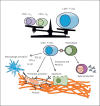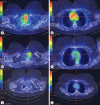Immunoglobulin G4-Related Thyroid Diseases
- PMID: 28101487
- PMCID: PMC5216195
- DOI: 10.1159/000452623
Immunoglobulin G4-Related Thyroid Diseases
Abstract
Immunoglobulin G4-related disease (IgG4-RD) is a new disease category involving many organ systems, including the endocrine system in general and the thyroid in particular. Since an initial association was made between hypothyroidism and autoimmune (IgG4-related) pancreatitis, more forms of IgG4-related thyroid disease (IgG4-RTD) have been recognized. Four subcategories of IgG4-RTD have so far been identified: Riedel thyroiditis (RT), fibrosing variant of Hashimoto thyroiditis (FVHT), IgG4-related Hashimoto thyroiditis, and Graves disease with elevated IgG4 levels. Although a male predominance is seen for IgG4-RD in general, RT and FVHT have a female preponderance. The pathogenesis of IgG4-RD is not completely understood; however, genetic factors, antigen-antibody reactions, and an allergic phenomenon have been described. Diagnosis of IgG4-RD requires a combination of clinical features, serological evidence, and histological features. Histology is the mainstay of diagnosis, with IgG4 immunostaining. Although serum IgG4 levels are usually elevated in IgG4-RD, raised serum IgG4 is neither necessary nor adequate for diagnosis. Imaging supports the diagnosis and is a useful tool in disease monitoring. Management of IgG4-RTD is both medical and surgical. Steroids are the first-line treatment and may produce a swift response. Tamoxifen and rituximab are second-line agents used in steroid-resistant patients. Surgical debulking is carried out in RT solely as a procedure to relieve obstruction. Other endocrine associations described with IgG4-RD are hypophysitis and Hashimoto encephalopathy. IgG4-RTD is an uncommon disease entity, and prompt diagnosis and treatment can improve outcomes.
Keywords: Graves disease; Hashimoto thyroiditis; Immunoglobulin G4; Riedel thyroiditis; Rituximab; Tamoxifen.
Figures



References
-
- Hamano H, Kawa S, Horiuchi A, Unno H, Furuya N, Akamatsu T, Fukushima M, Nikaido T, Nakayama K, Usuda N, Kiyosawa K. High serum IgG4 concentrations in patients with sclerosing pancreatitis. N Engl J Med. 2001;344:732–738. - PubMed
-
- Geyer JT, Ferry JA, Harris NL, Stone JH, Zukerberg LR, Lauwers GY, Pilch BZ, Deshpande V. Chronic sclerosing sialadenitis (Küttner tumor) is an IgG4-associated disease. Am J Surg Pathol. 2010;34:202–210. - PubMed
Publication types
LinkOut - more resources
Full Text Sources
Other Literature Sources
Miscellaneous

